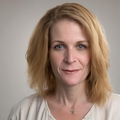.webp)
How to Sit with SI Joint Pain? Guide for Posture & Tips
Table of Contents
Learning how to sit with SI joint pain is essential, especially considering it doesn't change the fact that work must get done and productivity must be maintained. It's not that your organization doesn't care that you have sacral pain when sitting, but this is one of the realities of life.
Should you suffer from the condition, then you likely spend a lot of your time trying to learn how to relieve SI joint pain. That's what all the information here today is about. First, things start with defining SI joint pain, so awareness can be spread about what sacrum pain when sitting may look like.
After that, there is a brief guide on SI joint pain sitting, teaching you how to do it correctly for the best results. Proper sitting posture is important for everyone, and even more so for those that may be suffering from such a condition.
An appropriate office chair is required for people who fall under this category, so things wrap up with a quick look into some of the best options for an ergonomic chair with back support. The focus is not necessarily on a chair for upper back pain, though the units identified help with this too.
Hopefully, by the time you are finished reading, you have learned more, not only about the condition, but also about what you can do in the office space to mitigate its effects. Who knows? It may not necessarily be for you.
Maybe you know someone who needs to learn how to sit with SI joint pain. If so, don't keep your newfound knowledge to yourself, but instead, share it with those who may need it most.
What is SI Joint Pain?
First, “SI” is used to shorten the word sacroiliac. This is a kind of joint that you have on both sides of your body. Your sacrum and your ilium bones join here. As you may know, wherever you have two bones meeting, it's called a joint.
For reference, your ilium is your hip bone, and your sacrum is a flat and wide bone found between your lumbar spine and your tailbone.
These are not the same kind of ball and socket-type joints that you may find in your elbow or knee. Therefore, the actual joint site doesn't move very often, and thick ligaments hold everything together. By default, people don't necessarily have problems with their SI joints, though it is not unheard of.
Instead, repetitive stress or sudden ergonomic injuries cause the joint to create pain as it becomes more inflamed over time. You may notice this pain hovering around your lower back or your buttocks.
Note that it's not always because of inflammation, injury, or stress though. Certain phenomena, such as pregnancy or conditions, such as ankylosing spondylitis, can certainly have quite a detrimental effect on the spine and lead to SI joint pain.
A sedentary lifestyle is also a potential causative factor, as sitting for extended periods is almost a surefire way to either aggravate pain that's already present or introduce pain to your SI joints.
However, provided you know how to sit with SI joint pain and how to relieve SI joint pain, you can certainly reduce the amount of pain that you feel or mitigate it altogether. With that said, it's time for you to learn how to sit properly if you want SI joint pain relief.
What is the Correct Posture to Sit with for SI Joint Pain Relief?
As indicated before, you have a series of thick ligaments that are present at the joint site. Their purpose is to transfer force between your leg and trunk whenever you run or walk. With the joint pain present, whenever you're in a position that introduces stress on your ligaments, you can end up dealing with irritation or even greater pain.
As you sit, the rule of thumb is to always maintain a neutral position. You may hear these instructions provided to persons even when they're not dealing with SI joint pain. For someone who has the condition, it's even more essential. Greater focus must be placed on keeping the hips neutral, as doing so can eliminate the stress on the ligaments mentioned.
The best way to achieve this is to imagine maintaining a position that allows your hips to be level with each other. Sometimes, people sit in a way that creates a bit of a slope. Therefore, one hip is lower than the other.
Even when sitting on a completely flat surface, people also sometimes lean to one side, causing an imbalanced distribution of pressure. Once there is any kind of asymmetry present, you are setting yourself up for SI joint pain.
Crossing the legs is often a very comfortable position, especially for women. Well, you may want to know that this position is highly conducive to SI joint pain, so you may want to reconsider using it.
First, as you sit, try to keep your chest up as much as possible. You don't want to keep things on the tense side of the spectrum, so do your best to lower your shoulder blades and relax. If you are tense, then you are going to start feeling pressure and discomfort in other areas, which you want to avoid.
Your knees need to be slightly apart, and as mentioned before, you don't want them to be crossed. You want to remain in constant and balanced contact with your chair, ensuring that the tops of both hips are level with each other.
Not every chair supports your lower back effectively, so if yours doesn't, you may need to introduce a pad or cushion into the equation behind your lower back.
If you sometimes sit on the floor for whatever reason, you may want to use what is known as the tailor’s position, which helps to maintain a neutral pelvis and cut the amount of stress that your SI joint must deal with. Again, symmetry in the hips is essential.
As you sit on the floor, ensure that your “sit bones” are firmly pressed on the floor and that a constant contact surface is maintained throughout. Now, you cross your legs, ensuring that each foot is underneath a thigh. Again, your chest should be up and your shoulder should be relaxed.
This is probably the only time you're going to be advised to cross your legs, as here, it contributes to relieving SI joint pain while sitting. Note that you can achieve the tailor’s position without being on the floor. To this end, you want to sit on some other firm and flat surface.
Final Remarks
Now, you should be way more equipped with information where SI joint pain sitting is concerned and how to sit with SI joint pain. Maybe you already knew that you had a challenge in this area, or you had the pain and did not know exactly what you were experiencing.
Well, you can identify what the challenge looks like and how to relieve SI joint pain by adopting a proper posture when you sit. Furthermore, you are now aware that a proper office chair for SI joint pain can help you to stave off the physical challenges that the pain can bring.
You were even given a high-level overview of a couple of the chairs that you can consider as a part of the solution.
.svg)







